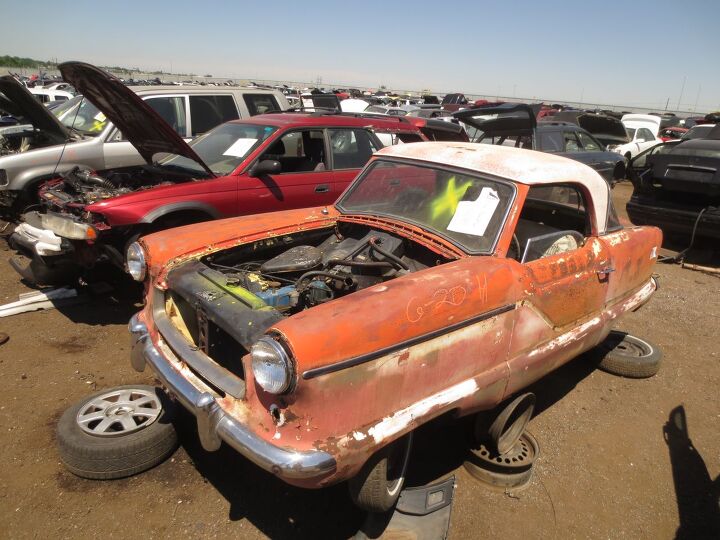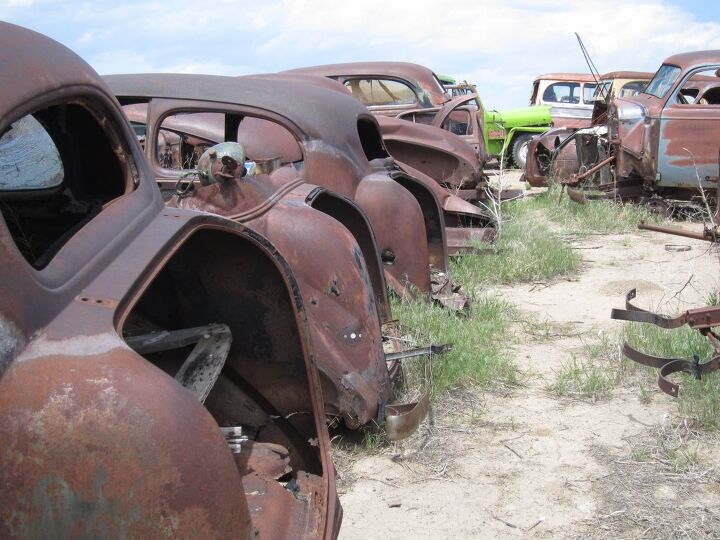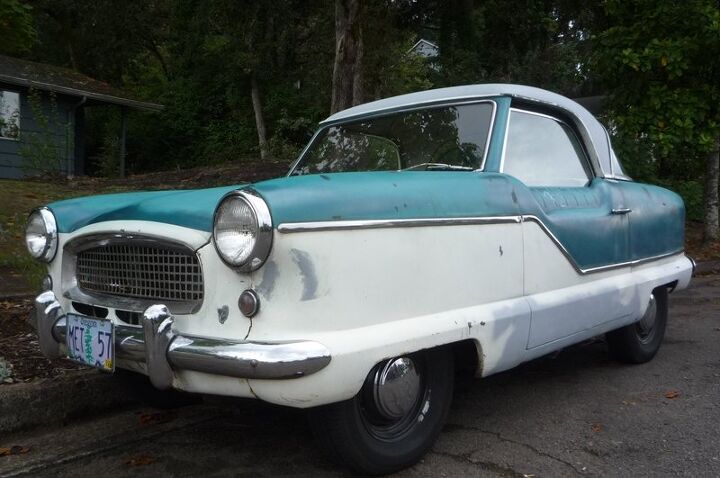#Nash
Rare Rides: The Unique Looking 1955 Nash Statesman
About a year ago Rare Rides featured its first Nash, the tiny Metropolitan. Today we take a look at the full-size car that occupied the showroom floor alongside its smallest sibling.
Hailing from 1955, it’s a Statesman.
Rare Rides: A Microscopic American Motors Metropolitan From 1962
Recently, we featured a grandiose convertible Hudson once owned by actor and car enthusiast Steve McQueen. Today’s Rare Ride came originally from Nash, the other company which combined with Hudson to form American Motors.
Let’s get Metropolitan.
Happy 100th Birthday, Nash Motors!
Sure, none of the original players are walking the earth, but we can still celebrate the corporate creation of Charles W. Nash, the man who quit General Motors in its infancy to form his own car company.
Nash Motors wasn’t a Big Three player, but it did make its mark on the automotive landscape. During a wild ride of mergers, acquisitions and changing product direction, the independent automaker spawned a number of innovations that became industry firsts.
Walter P. Chrysler Museum to Reopen to Public
Just two days after Cadillac announced opening up what they hope will be an au courant coffee shop on the ground floor of its trendy lower Manhattan digs, Fiat Chrysler announced it will reopen the Walter P. Chrysler Museum, on the grounds of Chrysler’s campus in slightly less trendy Auburn Hills, on June 4th.
The museum, which first opened in 1999 when Daimler owned Chrysler, has displays that cover the history of the current Chrysler brands along with the company’s former nameplates, starting with a 1902 Rambler from the Jeffrey company (the progenitor to Nash) and American Motors.
Junkyard Find: 1957 Nash Metropolitan
When we had a 1960 Nash Metropolitan Junkyard Find a couple months back, you may have thought “Well, that was a once-in-a-lifetime occasion!” As it turns out, finding examples of the little Austin-built proto-AMC commuter in cheap self-service wrecking yards isn’t difficult at all— here’s another one, discovered at a yard in Denver.
Junkyard Find: 1960 Nash Metropolitan
I find 1960s cars in self-service wrecking yards all the time, but the last time I saw a Nash Metropolitan in this type of yard was, I think, in 1983, at the long-defunct U-Pull in east Oakland. I went back to the East Bay last weekend to visit family and decided to visit some of my favorite yards while I was there. I thought maybe I was hallucinating from the 90-degree heat and the endless rows of Tauruses, but no— this is a rust-free, complete Metropolitan!
Junkyard Find: 1951 Nash Airflyte
Why does a car need wheel openings in the front fenders, anyway? The Nash Airflyte, aka the “Bathtub Nash,” proved that long, low, and wide (and a postwar American car-buying public starved for anything with four wheels and an engine) would move the iron off the showroom floor in the late 1940s and early 1950s. I’ve been thinking about building an Airflyte-based project car lately, so I returned to the Brain-Melting Colorado Junkyard to do some window shopping.
Corvairs, Kaisers, and Cadillacs: Brain-Melting Colorado Junkyard Is a Mile High… and a Mile Wide
That AMC Matador Barcelona we saw last week was quite a Junkyard Find, but it represents approximately 0.01% of the staggeringly tempting potential Hell Projects in this particular Colorado yard. Located not far from Pikes Peak (which I couldn’t see because of all the wildfire smoke), this not-open-to-the-public junkyard/open-air automotive museum is owned by a man with an eye for interesting Detroit iron and all the land he needs to store what he finds. After all my years of junkyard crawling, I think this may well be the Greatest Yard of Them All, and that includes the now-defunct Seven Sons yard and this 70-year-old yard north of Denver. Let’s take a little tour, shall we?
Down On The Junkyard: Time Stops At Ancient Colorado Yard
Most of my junkyard-prowling experience has taken place at the modern-day self-service yards, where the inventory turns over fast, prices are standardized, and 90% of the cars on the yard tend to be 15 to 20 years old. Now that I’m in a constant search for parts for a 45-year-old Dodge van, I’ve been venturing out to the more traditional wrecking yards, where you haggle for every part and the inventory sits for decades while each and every salable part gets picked. A couple weeks back, I went on a quest for A100 parts at a breathtakingly vintage junkyard located about halfway between Denver and Cheyenne.
For Memorial Day: The Arsenal of Democracy – The Independents
General Motors was the largest supplier of war materiel to the American armed forces. Ford famously built B-24 Liberators that rolled off the Willow Run assembly line at a rate of one per hour. Chrysler alone built as many tanks as all the German tank manufacturers combined. With those high profile contributions to the war effort made by the big three automakers, it’s easy to forget that the independent automakers (and automotive suppliers as well) also switched over completely to military production.
Curbside Classic: 1957 Metropolitan
Americans generally just don’t take too well to tiny cars. Perhaps they’re too much like toys, not really yet grown up? The Metropolitan certainly looks the part, resembling an amusement park ride or clown car rather than a genuine automobile a self-respecting grown-up American would drive. And this particular Metro only reinforces that stereotype: it’s owner is fourteen, and he’s owned it since he was ten. “Dad, can I have this cool car?”
An Illustrated History Of Automotive Aerodynamics – In Three Parts
[Note: A significantly expanded and updated version of this article can be found here]
That air presented the greatest obstacle to automotive speed and economy was understood intuitively, if not scientifically since the dawn of the automobile. Putting it into practice was quite another story. Engineers, racers and entrepreneurs were lured by the potential for the profound gains aerodynamics offered. The efforts to do so yielded some of the more remarkable cars ever made, even if they challenged the aesthetic assumptions of their times. We’ve finally arrived at the place where a highly aerodynamic car like the Prius is mainstream. But getting there was not without turbulence.



























Recent Comments